Cohen, Peter (1989),
Cocaine use in Amsterdam in non-deviant subcultures. In: Peter Cohen (1990),
Drugs as a social construct. Dissertation. Amsterdam, Universiteit
van Amsterdam. pp. 148-152.
© Copyright 1990 Peter Cohen.
All rights reserved.
11. Quality of cocaine
Peter Cohen
- 11.1 - Introduction
- 11.2 - Adulterants
- 11.3 - Amphetamine ('speed') in cocaine
- 11.4 - Purity of cocaine
Table of contents
11.1 Introduction
Usually, illegal drugs are not offered in a pure form to consumers. Some of the impurities found in illegal drugs are residues of the production process, so even 'pure' cocaine contains about 10% of production impurities. Pharmaceutically pure cocaine with an extremely low percentage of impurities is rarely found on the black market.
Apart from residues of the illegal production process, distributors in the illegal network often add adulterants to cocaine in order to increase its volume.
Table 11.1.a Frequency of prevalence of adulterants in cocaine according to respondents
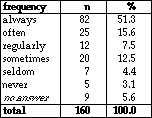
In our survey of cocaine users in Amsterdam we bought cocaine from respondents. A small sample of about 50 mg was normal with respondents that had any cocaine available at home. This would enable us to know the quality level of cocaine in our user population and to check the reliability of the user's opinions on quality and adulterants. This also offered a cross check on respondents' knowledge when answering questions about cocaine: did they have some white powder containing less than 10% of cocaine hydrochloride, or a substance pure enough to make them really knowledgeable about cocaine?
11.2 Adulterants
We asked respondents if they knew wherever cocaine they bought contained adulterants. Almost 80% of the respondents thought that their cocaine was from 'always' to 'regularly' contaminated with adulterants. When asked which adulterants were used almost half of the respondents said 'speed'. Many possible adulterants were mentioned, of which mannitol and laxative most frequently. One quarter of the respondents could not give a precise name, and answered with terms like 'anything', 'garbage' or 'dirt'.
Table 11.2.a Adulterants used for cocaine according to respondents (N=160)
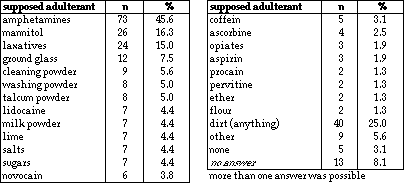
11.3 Amphetamine ('speed') in cocaine
As we expected, amphetamine was the most often mentioned adulterant in 'cocaine'. After we had given respondents the chance to mention any adulterant they knew, we asked them if they were able to sense the presence of amphetamines in cocaine. Of all respondents 84% answered in the affirmative.
In Table 11.3.a we present the effects of cocaine, according to respondents, when it is adulterated with amphetamine. Almost exclusively, effects are indicated that are perceived after consumption of cocaine, most of them some time after ingestion. We introduced a category of 'other physiological effects' with characteristics of speed that were mentioned by very few respondents (1 or 2): diarrhoea, bad feeling in gums, cramps, a burning feeling, feeling ill, a tense stomach, no freeze, pain in neck muscles. The category 'other mental effects' contain: more talkative, becoming highly preoccupied, a feeling of distance towards other people, anxiety. Most of these effects are mentioned as cocaine effects by other respondents, as reported in chapter 10. The category 'other' contains answers that refers to outcome of tests, different effects on genitals, time between consumption and onset of effects, etc.
The following table shows that the effects of amphetamine are most often felt as unpleasant. We have to assume that the reported negative effects of 'speed' in cocaine are in many cases cocaine effects, or effects of cocaine in combination with another drug.
Table 11.3.a Effects of amphetamine in cocaine according to respondents (N=160)
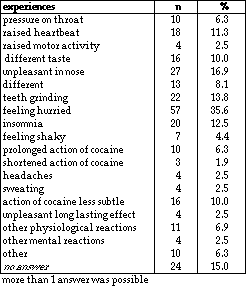
11.4 Purity of cocaine
Of 160 respondents in our survey, 45 had cocaine available in their homes and were willing to sell a sample of ca 50 mg in exchange for Ÿ50[1].
Purchased cocaine was packed in a special plastic container that was then closed before being sealed into a small polythene bag. Sealed bags were delivered to the Central Police Laboratory in Amsterdam. Samples were investigated for impurities and for content of cocaine hydrochloride with different methods: thin layer chromatography, liquid chromatography and IR spectrometry. Some samples were also investigated by capillary gas chromatography.[2]
Six of the samples did not contain any cocaine at all. We traced two respondents that admitted to have cheated the interviewer, one with sodium carbonate and one with ground glass of an electric lamp. A third respondent later inquired about the results of the test of his cocaine. He stated his usual dealer had been on holiday, and he had bought the cocaine he sold us somewhere else. According to him the powder was not cocaine. We had strong doubts about this story. According to the laboratory test his sample was pure gastric sodium, a chemical substance readily available in almost any household. The other three non cocaine samples contained lidocaine (80%), ascorbine/vitamin C (100%) and gastric sodium (100%). Of course we do not know if all respondents deliberately cheated us or if some of them were cheated themselves. But we strongly suspect that these 6 respondents deliberately cheated our interviewers, so that these six samples can not be taken as making part of the normal spectre of variance in black market cocaine purity. Therefore we will only use the samples that contained at least some cocaine for the remainder of the analysis. The purity of the remaining 39 samples will be given as a percentage of cocaine hydrochloride. Purity had a range from 14.0% to 90.4%. Average purity was 65.1%.
As can be seen in table 11.4.a two thirds of the samples that contained any cocaine at all were 60% or more pure.
Table 11.4.a Purity in percentages of cocaine hydrochloride in 39 samples
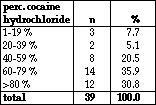
We asked respondents who sold us cocaine what adulterant would be found in it. Answers were: none (5), amphetamine (3), mannitol (5), glass (1), laxative (4) and 'dirt' (18). After laboratory testing the samples, we found all respondents were wrong.
The adulterations we found were Daro(TM), an anti headache powder consisting of a mixture of paracetamol, coffein and propyfenazon (3); ascorbine/ vitamin C (2); coffein (1); sugar (1); nicotinamide (2); lidocain (1); mannitol (2) and sodium bicarbonate (3). Apart from the Daro(TM) mixture, we found another mixture consisting of 3.5% caffein, 6.4% lidocain and the rest mannitol (2). Except from the five samples adulterated with (standard) mixtures mentioned all other adulterated samples were adulterated with only one substance.
Comparing the assumptions about the adulterants in cocaine with actual findings, we see that respondent judgment is poor. But, as is shown in the Table 11.4.b, testing methods used by cocaine buyers in Amsterdam are also poor.
Table 11.4.b Method of testing cocaine before buying
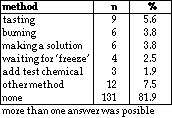
A very large majority of the respondents (81.9%) do not test at all. But, our test results also revealed that the quality of cocaine found with users in Amsterdam is reasonable or good. This may explain the absence of frequent sophisticated testing by our respondents. Another explanation is of course, that a reliable test of the quality of cocaine is both technically difficult and time- consuming. Most users spend relatively small amounts of money on cocaine, which makes testing not cost effective.
